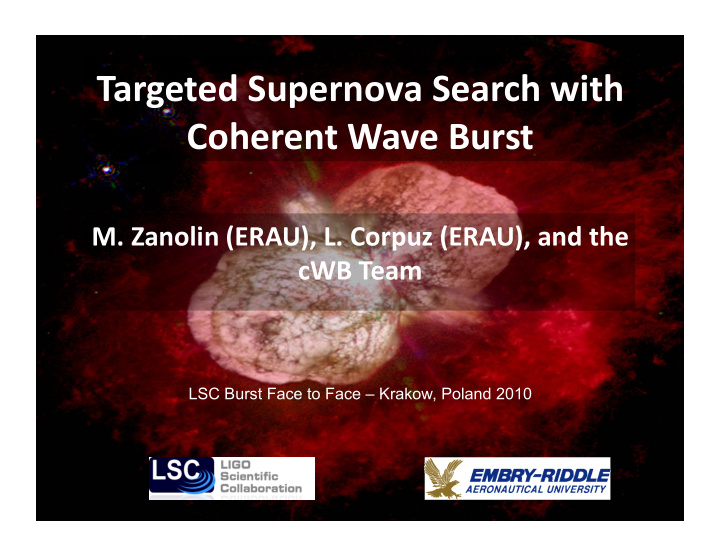



Targeted Supernova Search with Coherent Wave Burst M. Zanolin (ERAU), L. Corpuz (ERAU), and the cWB Team LSC Burst Face to Face – Krakow, Poland 2010
Why can we benefit from a new approach to Supernova searches? The light curves below can be used to back track from the first recorded signal to the probable time of the explosion Kaufman et al. 2010 As we can see from this table, the uncertainty in the explosion time ranges from ±6 sec to ± 4 days. For the list of optically detected SN within ~20Mpc during S6, the uncertainty may be even longer.
Op8cally Discovered SN Within 20Mpc During S6 SN Name SN Type Host Galaxy Distance 2010u ? NGC 4214 ~2.7‐3.5 2010k IIp 12 02 46.67 +02 24 05 ? 2010gi IIb IC 4660 ~16.4 2010br Ib/c IIb NGC 4051 ~10.9 2009mk II ESO 293‐34 ~18.3 2009md II NGC 3389 ~15.9 2009ls II NGC 3423 ~10.9 2009kr IIn NGC 1832 ~14.2 2009js II NGC 0918 ~17 2009ip II NGC 7259 ~20 2009ib IIp NGC 1559 ~12.6 2009hq IIp NGC 4152 ~13.1 These were taken from a complete list compiled by CBAT http://www.cfa.harvard.edu/iau/lists/Supernovae.html
Search Configura8on The standard configura8on of cWB will be modified by introducing a sky mask, • during produc8on, to both the foreground and the background runs. The smallest sky mask we can implement is 0.5°x0.5° (one pixel). We are also exploring larger sky masks to keep into account the angular resolu8on. - The frequency band we will use will be from 100‐2000Hz. - The characteris8c GW frequency evolves from ~100 Hz just a_er bounce to ~300‐400 Hz, with higher frequencies corresponding to higher mass progenitors… ‐ hap://stellarcollapse.org/gwcatalog/murphyetal2009 [PNS Core Pulsation] C. Ott - http://tapir.pbworks.com/f/Ott_CCSN_GW_predictions.pdf
Search Configura8on Con8nued • We will use larger windows, on the order of weeks, to include the error in extrapola8ng the exact 8me of the first EM SN emission • haps://svn.ligo.caltech.edu/svn/snsearch/papers/surf_report2010/ • PNS Pulsa8on models suggest we search within ±1day of the first EM signature – Luc Dessart - http://tapir.pbworks.com/f/Dessart.pdf • In collabora8on with the CalTech effort, we will perform simula8on studies with the following waveforms: 1. Analy8c Bar Modes 2. Convec8on/SASI 3. PNS g‐modes 4. More? • Data quality will be handled the same way as the all‐sky cWB search on S6 • We are working on procedures to combine double and triple coincidence data both for detecKon and upper limit purposes.
Expecta8ons and Time Scales • We expect to improve the sensi8vity of the all‐sky all‐ 8me search by a factor of 2 S. Klimenko http://tapir.pbworks.com/f/caltechSN.pdf • • We might not be able to conclusively determine the supernova mechanism from the waveform. See C. Oa’s discussion at: • http://stellarcollapse.org/talks/Ott_APS_April_2008.pdf • We aim to do the analysis and produce a paper in about a year
Recommend
More recommend